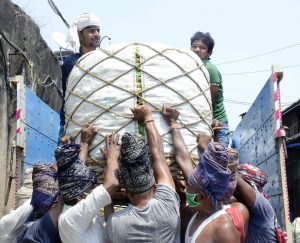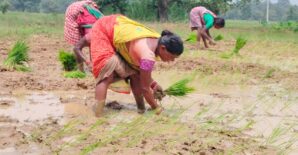Government of India listed all food commodities as essentials allowing their free movement with a hope to avoid disruptions in food value chain during the COVID-19 lockdown. Neelkanth Mishra argues that despite such provisions, large parts of agricultural value chains continue to be impacted. A big contributor to this has been the demand shock, resulting from income loss and precautionary consumers’ behaviors. This effect is most pronounced in perishables, especially in animal sourced food. Yet, Neelkanth argues, the COVID-19 induced lockdown has opened significant opportunity for reforms in Indian agri-food markets. – Shahidur Rashid, series co-editor and Director, International Food Policy Research Institute, South Asia.

Kolkata, labors unload vegetables at a wholesale market during the nation wide lock down imposed to contain spread of COVID 19. Saikat Paul
“We have stopped giving boiled eggs in school”, my father told me during one of our routine Sunday morning chats in late January. He added that parents of students in the pre-primary school (that my parents manage in Bokaro, India for under-privileged children) feared that eating boiled eggs would expose their children to coronavirus. This was more than two months before Bokaro got its first infection. Soon after that episode, I saw an online video of chicks that were a few days old being dumped into a landfill. While early slaughter of birds is a standard industry response to weak demand (sale just ten days before normal can curtail meat volumes by 20-25%, and vice versa), culling chicks meant that demand for chicken meat had fallen sharply. In a visit to tribal areas, just 120 km north of Mumbai in early February, a shopkeeper confirmed that no one was buying chicken – next to her shop, a dry tree-stump with a cleaver was standing testimony to this. By March, prices of chicken had collapsed.
A lockdown cannot stop people from eating and limit crops from growing. Even in the most severe first three weeks of lockdown, agriculture and food supply chains, deemed essential, were permitted to continue. Theoretically, that should have kept agriculture immune from the disruptions seen elsewhere in the economy, but reality is different, as seen above. Various parts of agriculture are seeing severe near-term as well as medium-term disruption, in addition to the first signs of deep structural reform.
Non-perishables (least impacted) are 85% of acreage, but only a third of output by value
It is worth reminding ourselves that non-perishables like cereals, pulses, oilseeds and fibers, which together account for 85% of acreage in India, are less than a third of India’s agricultural output by value. For most of these commodities, production should not have seen much disruption (but for some challenges with labor for the rabi harvest and availability of seeds for kharif). Delays in marketing and distribution are less damaging, as the farmer can hold on to the grains for a while. However, a significant part of the remaining two-thirds has been severely hit.
Continuing with the business of chicken, mutton, fish and eggs, the demand weakness starting in January was due to fear of the virus, and should be temporary. The challenges of selling during the lockdown, when the wet markets, where most of meat and fish is sold in India, were closed, should also be short-lived, as should be the impact on demand from closure of restaurants (though these could take many months to restart fully). However, the demand for proteins and fats is strongly correlated to income growth over the medium-term, and expectation of subdued income growth even after the lockdowns are lifted could slow demand for these categories.
The upstream supply chain for meat is already seeing these problems: the bumper output of corn, for example (used in making chicken-feed, usually together with soybean) in India now has to be sold at a price nearly a third below last year’s peak in Augusti. Globally, corn has fallen more than 20% since January, and is now at the lowest levels in more than a decade as wellii.
Slowing income growth hurts demand for proteins and fats
Demand problems are also showing up in milk, which, we must remember, accounts for a fifth of agricultural output, and is larger than cereals and pulses in value – about 60% comes to the market, and the rest is self-consumed. Milk production and procurement in India have not been impacted as severely by the lockdown. This is a significant achievement, given its perishable nature and the shortages of trucks and drivers (although 30-40% of longer distance movement has been managed by train). However, shortened selling windows and closure of tea shops and restaurants due to the lockdown have affected the demand, with some of these taking several months to normalize. Amul estimates that milk demand has reduced nearly 10% from pre-lockdown levels.
While this, like the drop in sales of ice-cream or milk powder, should be temporary, there are global demand concerns too. Skimmed milk powder prices have decreased by more than a fifth since January, reversing the sharp increase seen in the second half of last year. Weak global skimmed milk powder prices tend to dampen local milk prices, even though only 1% of India’s milk output is converted to powder.
The lockdown may help accelerate the share gains for organized milk procurement and some consolidation. This is evident with smaller unorganized buyers who appear to be struggling, whereas some cooperatives, on the other hand, have seen 20-25% higher procurement.
Closure of mandis and disruption of supply chains open up opportunity for reforms
While the milk supply chain has managed well, other perishables like fruits and vegetables have not, as there has been a sharp 50-75% drop in market arrivals nationallyiii.Though anecdotal evidence points to a bumper harvest, shortages of trucks, labor (for loading and unloading material), and in some cases (like the Lasalgaon onion market near Nashik), the market itself shutting down because of someone nearby getting infected by the virus, have meant low market volumes. For non-perishable rabi crops like wheat and chana, this means higher cost for the farmer (cost of holding inventory, as well as multiple trips to the market as social distancing norms limit the quantity that can be sold in one go). For summer fruits like mangoes, the season is lost. Vegetable prices were already correcting from abnormally high levels since July last year. It is hard to say how much of the 30-60% decline in prices in 2020iv is due to disruptions in either demand or market, but impact on the market is clearly evident from the statistics.
That said, the damage to producers and consumers might have been limited by the relatively short supply chains for a significant part of the highly perishable vegetables in India (as against onions and potatoes, where a meaningful proportion tends to cross-state borders).
Interestingly, this disruption in markets has opened up an opportunity for structural reforms. The long overdue dismantling of the monopoly of the Agricultural Produce Marketing Committees (APMCs) has now occurred due to the necessity of bringing food from farmers to consumers, when a large number of the mandated markets are not operational, or have seen their throughput impaired by social distancing norms. Using this disruption as an opportunity, the union government has embarked on bold reforms in agricultural distribution, by promising amendments to the Essential Commodities Act (ECA), as well as proposing a new law (Agricultural Produce Trade & Commerce Facilitation Act) that will allow buyers and sellers to bypass the APMCs. In combination with changes to the ECA, this can catalyze significant investment in infrastructure, boost food-processing, and encourage farmers to move up the value chain.
Since agriculture is a state subject, several states have also been undertaking reforms. Some have permitted large buyers like modern retail chains as well as e-commerce grocery companies to buy directly from farmers, while others have allowed farmers to collectively sell produce in nearby cities (e.g., in Satara, Maharashtra), albeit temporarily. The longer the lockdown lasts, the more these changes will be hard to reverse, even if the political economy attempts a return to the older system. The state of Madhya Pradesh has, in fact, promulgated an ordinance amending its Mandi Act, whereby, warehouses to silos to cold storages could be declared a private mandi (market), and APMCs would not be interfering in private mandis.
Another tentative evidence of a long-desired change can be seen among farmers in Punjab, who are moving away from paddy (where India continues to have significant surpluses, and continuing farming of this water-intensive crop was depleting groundwater in Punjab) due to the expected shortages of labor for transplanting paddy in the upcoming kharif season. This, however, may just be a temporary arrangement.
A question mark over medium-term demand growth for food calories
Over the next few quarters, as economies around the world relax their lockdown, and till some cure or vaccine for the virus is found, agricultural supply chains are likely to see further volatility. For example, resuming production of various types of meat would take time. However, even after supply normalizes, demand growth for energy, consumed as food, may stay weak, as income growth across the globe may be weaker than what it has been over the past two decades. This could exacerbate the oversupply created by the remarkably steady improvement in global agricultural output. The price decline in crude oil has already lowered the price of oilseeds, given the linkages with biodiesel.
Given the impact of global factors on agriculture in India being far more than in the popular consciousness, global price weakness could create long-term stress on agricultural income.
Neelkanth Mishra is a Managing Director, the India Strategist and Co-Head of Equity Strategy, Asia Pacific, for Credit Suisse. The analysis and opinions expressed in this piece are solely those of the author.
This blog has been published as a part of the International Food Policy Research Institute (IFPRI), South Asia, blog series on analyzing the impacts of the COVID-19’s pandemic on the sub-national, national, and regional food and nutrition security, poverty, and development. To read the complete blog series click here
i As per CMIE, prices had climbed above Rs 21/kg in August last year, but are at Rs 15 currently.
ii As per tradingeconomics.com, prices on 1 January were at US$ 387/bu, but it is US$ 313/bu now
iii Mandi arrival data from agmarket.nic.in till end-April for crops like wheat, chana, onions, mangoes, etc.
iv CMIE daily prices for vegetables
New research from a Special Issue of Applied Economic Perspectives and Policy
The pandemic caused disruptions to both the supply of and demand for health services that persisted past the lifting of lockdown measures.
Public food transfer programs have traditionally been the most common social protection programs in Bangladesh



